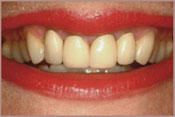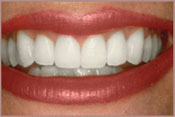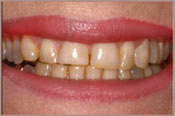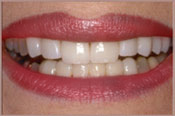Teeth Whitening | Veneers | Crowns and Bridges | Composite Bonding
Teeth Whitening
Your teeth will darken over time. Changes in the color of your teeth can be caused by such factors as the food and beverages consumed (like coffee, tea and soda). Other known factors for discoloration may include childhood medications or illnesses, tobacco use or improper oral hygiene.
We are trained professionals using industry-approved methods. Our goal is to meet the needs of every patient, and every patient's needs are different. One of the methods used by our practice is a gentle at-home hydrogen-peroxide solution. Our process will whiten your entire smile in the comfort of your own home in only a few short days.


Veneers
Veneers are thin, semi-translucent "shells" typically attached to your front teeth. Veneers are customized from porcelain material and permanently bonded to your teeth. Veneers are a great way to improve the appearance of your smile with minimal modification to the existing tooth structure.
Common problems that veneers are used for:
- Spaces between the teeth
- Broken or chipped teeth
- Unsightly, stained or discolored teeth
- Permanently stained or discolored teeth
- Crooked or misshapen teeth
Veneers are a great aesthetic solution to your smile that may even help you avoid more aggressive treatment. Subtle changes to your smile can be achieved with veneers, and in most cases, veneer application is completed in only two office visits.
Please contact our office if you have any further questions on veneers.


Crowns and Bridges
Crowns
A crown is a permanent covering that fits over an original tooth that is either decayed, damaged or cracked. Crowns are made of a variety of different materials such as porcelain, gold, acrylic resin or a mix of these materials.
The treatment plan for a patient receiving a crown involves:
- Numbing the tooth to remove the decay in or around it.
- Re-sculpturing the tooth to provide an ideal fit for the crown.
- Making an impression of your teeth in order to create a custom-made crown (usually takes two to three weeks).
- Making a temporary crown out of acrylic resin and fitting it onto the tooth during the interim period when the permanent custom-made crown is being created.
- Applying the permanent crown (when received back from the lab) by removing the temporary crown and fitting the permanent one onto the tooth.
- After ensuring that the crown has the proper look and fit, the dentist cements it into place.
This process generally consists of a minimum of two to three visits over a three to four week period. Once the procedure is completed, proper dental hygiene, including daily brushing and flossing, is required to maintain healthy, bacteria-free teeth, gums and crowns. This helps in the prevention of gum disease. Given proper care, your crowns can last a lifetime.
Bridges
A bridge is a dental device that fills a space that a tooth previously occupied. A bridge may be necessary to prevent:
- Shifting of the teeth that can lead to bite problems (occlusion) and/or jaw problems and resultant periodontal disease.
- Bridges safeguard the integrity of existing teeth and help maintain a healthy, vibrant smile.
There are three main types of bridges, namely:
- A fixed bridge is the most popular and consists of a filler tooth that is attached to two crowns, which fit over the existing teeth and hold the bridge in place.
- The "Maryland" bridge is commonly used to replace missing front teeth and consists of a filler that is attached to metal bands that are bonded to the abutment teeth. The metal bands consist of a white-colored composite resin that matches existing tooth color.
- The cantilever bridge is often used when there are teeth on only one side of the span. A typical three-unit cantilever bridge consists of two crowned teeth positioned next to each other on the same side of the missing tooth space. The filler tooth is then connected to the two crowned teeth, which extend into the missing tooth space or end
Composite Bonding
Bonding is a common solution for:
- Fixing or repairing chipped or cracked teeth
- Reducing unsightly gaps or spaces between teeth
- Hiding discoloration or faded areas on the tooth's surface
Often, composite bonding is used to improve the appearance of your teeth and enhance your smile. As the name indicates, composite material, either a plastic or resin, is bonded to an existing tooth. Unlike veneers or crowns, composite bonding removes little, if any, of the original tooth.
Composite bonding has many advantages:
- It is a quick process, which typically lasts less than one hour.
- It does not reduce the tooth's original structure and is relatively inexpensive.
- Composite resins come in many different shades and provide better matching of shades to the natural color of your teeth.
- Composite bonds, however, are not as durable and long-lasting as veneers and crowns and may need to be re-touched or replaced in the future.
Composite bonds stain more easily and therefore require proper care and regular cleaning. In order to ensure the longest possible duration of the bonding, composites should be brushed and flossed daily. Common staining elements include coffee, tea, tobacco, foods and candy.
